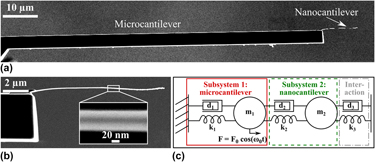Published online by Cambridge University Press: 14 September 2018

Dynamic-mode cantilever sensors are used in many different applications but especially in materials research to study properties of novel (nano)materials. Decreasing sample sizes require an increase in sensitivity of the analysis tools. For cantilever-based methods that is achieved through a reduction in cantilever dimensions. However, the increase in sensitivity has to be balanced with the detectability as also for a small cantilever a reliable detection of its oscillatory state has to be ensured. A recently introduced co-resonant measurement principle for cantilever sensors addresses this challenge by coupling and eigenfrequency matching of a micro- and a nanocantilever. Here, the sensor concept is reviewed with focus on the application in materials research by the instructive example of an iron-filled carbon nanotube, giving insight into the features and benefits of the sensor concept and demonstrating the reliable derivation of magnetic sample properties.